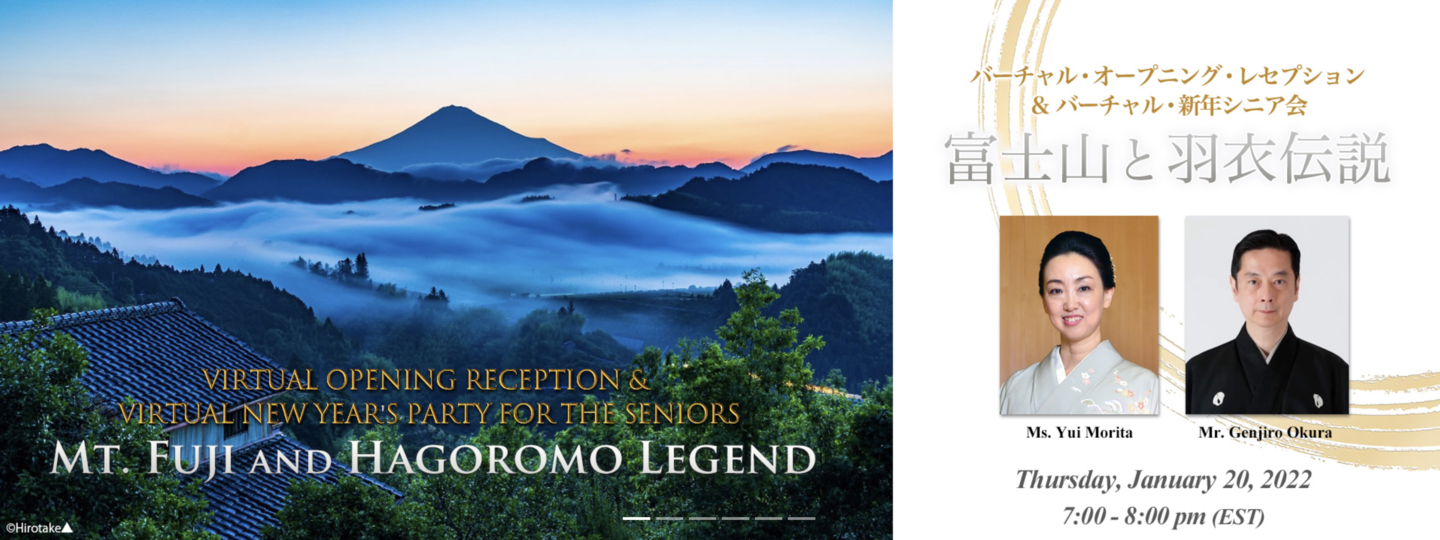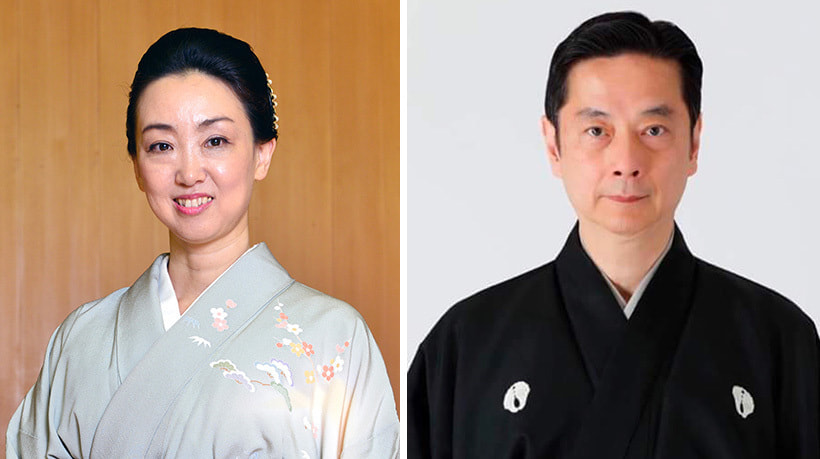
| タイトル | 日本クラブWEBギャラリー |
|---|---|
| 開催日時 | 2022年1月20日 〜 3月2日 |
| オープニングレセプション | 2022年1月20日 7pm〜8pm 参加費無料 先着500名樣まで お申込みはこちら |
| 主催 | 日本クラブ |
| 協賛 | The J.C.C. Fund (Japanese Chamber of Commerce and Industry of New York, Inc.) |
| 協力 | 愛知県美術館 秋田県立近代美術館 執行草舟コレクション 静岡県立美術館 静岡市三保松原文化創造センター「みほしるべ」 静岡市東海道広重美術館 東京富士美術館 長島美術館 平等院 フジヤマミュージアム |
| 監修 | 森田ゆい |
| キュレーター | 林祥子 |
写真家 山北裕丈(やまきた・ひろたけ)
1969年、富士山を望む静岡市に生まれ、四季折々の雄大な富士山の姿を見ながら育つ。水彩画を趣味とした祖父の遺品の一眼レフカメラで、風景写真撮影を本格的に始める。以後、地元静岡の富士山に傾倒し、富士山を撮り続けている。
羽衣伝説で知られる三保の松原は静岡県静岡市清水区にあります。室町時代、その地に伝わっていた羽衣伝説と駿河舞を結びつけて編まれたのが、能「羽衣」です。その舞台となる三保松原は、約7kmの海岸に約5万本の松が生い茂り、海岸に打ち寄せる白波、海の青さと松林越しに富士山を望む名勝地として知られています。毎年10月、天女が羽衣をかけたといわれる松の前で、「三保羽衣薪能」が上演されて来ました。
三保松原の羽衣伝説が日本文化に及ぼした影響は大きく、天女による音楽の演奏や舞は、雅楽において日本オリジナル作品の第一号となって伝えられ、現在でも宮中などで上演が続けられています。また、平等院に残る雲中供養菩薩像(楽器を演奏したり舞う菩薩像52体)は天女による音楽や舞の世界観の表現とされています。そして、能の「羽衣」は、能の代表的な演目として引き継がれています。羽衣をまとった天女は、 富士山と三保松原の美しい景色の上空を旋回しながら、ついには富士のかなたへと高く舞い上がり、霞にまぎれて消えていきます。山そのものを神と見立てる「富士信仰」は、自然崇拝の対象でもありますが、大規模な噴火を繰り返す富士山へ鎮まりの祈りから始まり、崇拝の対象へと変化してきたという歴史があります。富士山は2013年に「信仰の対象」と「芸術の源泉」という2つの側面を持つ文化遺産として世界遺産に登録されました。そして、三保松原も富士山のイメージを広く伝え、詩歌や絵画などに描かれる芸術の源泉地としてその構成要素に指定登録されました。
本展覧会では、三保松原に伝わる羽衣伝説にちなみ、日本を代表する富士山の絵画や撮影写真そして平等院鳳凰堂雲中供養菩薩像の画像約36点をご覧頂きます。
展示作品
① 富士山と羽衣伝説に関連する絵画19点
② 平等院「雲中供養菩薩像」画像10点
③ 写真家山北裕丈撮影の富士山の写真7点
バーチャル・オープニング・レセプション
&バーチャル・新年シニア会

本展監修の森田ゆい氏(東京立正短期大学准教授)に、三保松原に伝わる羽衣伝説についてご紹介頂きます。また、人間国宝の大倉源次郎氏に、能の代表的な演目「羽衣」についてのお話を頂いた後で、小鼓の実演(謡と小鼓による一調)を頂きます。
協力:謡 馬野正基氏(観世流シテ方能楽師)
大倉 源次郎(おおくら げんじろう)
能楽小鼓方大倉流十六世宗家。公益社団法人能楽協会理事。一般社団法人日本能楽会会員。1985年、宗家継承。2017年、重要無形文化財保持者「人間国宝」認定。大阪文化祭奨励賞、咲くやこの花賞(大阪市)、観世寿夫記念法政大学能楽賞などを受賞。著書に「大倉源次郎の能楽談義」「能から紐解く日本史」
森田ゆい(もりた ゆい)
東京立正短期大学准教授。NPO法人日本伝統芸能教育普及協会むすびの会事務局長兼任理事。学習院女子大学、明治大学非常勤講師。お茶の水女子大学大学院修士課程修了。伝統芸能実演家の技を科学的に検証する研究を専門とする。伝統芸能の普及活動として公演企画、学校機関での特別授業のサポートなどを行っている。著書に『ようこそ伝統芸能の世界 伝承者に聞く技と心』

| Title | The Nippon Club Web Gallery |
|---|---|
| Date | 2022.1.20 - 3.2 |
| Opening Reception | 2021.1.20 7pm - 8pm Free of charge up to 500 people, First come, first served Register Here |
| Organizer | The Nippon Club |
| Supported by | The J.C.C. Fund |
| In cooperation with | Aichi Prefectural Museum of Art Akita Museum of Modern Art Shigyo Soshu Collection Shizuoka Prefectural Museum of Art Shizuoka City Miho no Matsubara Culture and Creativity Center-Mihoshirube Shizuoka City Tokaido Hiroshige Museum of Art, Tokyo Fuji Art Museum Nagashima Museum, BYODOIN Fujiyama Museum |
| Director | Yui Morita |
| Curator | Shoko Hayashi |
Photos by Hirotake Yamakita
Born in Shizuoka City, he grew up beholding Mt. Fuji in its various magnificence in each turn of the season. He started full-scale landscape photography with a single-lens reflex camera, as he inherited the relic of his grandfather whose hobby was watercolor painting. Since then, he has been devoting himself to Mt. Fuji in his hometown of Shizuoka and has continued to photograph Mt. Fuji.
Miho-no-Matsubara, a pine grove on the Miho Peninsula, well-known by its Hagoromo legend, is located at Shimizu-Ku, Shizuoka city in Shizuoka-prefecture. Noh titled as “Hagoromo” combines two legends which are the story in regards to the origin of Suruga-Mai, Suruga dance, and the descent of a Tennyo, a heavenly woman or nymph, onto the beach. Miho-no-Matsubara stretches 7 kilometers long with about fifty thousand pine trees along the beach. With blue sea, white wave spray, and beautiful Mt. Fuji views, the scenic spot attracts tourists all over the world. In every October, Miho-no-Matsubara Takigi-Noh Play, Noh play by firelight, is performed in front of the pine trees, on which the Tennyo is said to have hung her feather mantle.
The Miho-no-Matsubara Hagoromo legend had given a significant influence on the culture of Japan. Musical performance and dance by Tennyo have been considered as the initial Japanese work in the Gagaku, a piece of classical Japanese court music, and is being played still now in the imperial court and some other places like shrines. Unchu- Kuyou-Bosatsu, 25 singing and dancing Statues of Bodhisatva, in Byo-do-In Temple is considered to express the thought on the world of music and dance. “Hagoromo” is currently being performed as the typical play of the Noh. Tennyo hovers in the beautiful scenery of Miho-no -Matsubara, a pine grove on the Miho Peninsula, and Mt. Fuji and rises high up to fade away in the fog.
“Fuji-Shinko, which regards the mountain itself as a god, is the animism that perceives Mt. Fuji has some spiritual value and power. However, it has a history of prayer asking for quieting the repeated large-scale eruption seems to have turned into mountain worship. Mt. Fuji was added to the UNESCO World Heritage Site List in 2013 as “Sacred Place” and “Source of Artistic Inspiration.” Miho-no-Matsubara conveying the beauty of Mt. Fuji is also added to the UNESCO World Heritage Site List as “Artistic source for Poetry and Paintings.”
We are proud to introduce 36 paintings and photos of Mt. Fuji and Tennyo in relation to the Hagoromo legend of Miho-no-Matsubara.
Exhibition Artworks
① 19 of paintings related to Mt. Fuji and Hagoromo Legend
② 10 of “Unchu Kuyo Bosatsu” in BYODOIM
③ 7 photos of Mt. Fuji by photographer, Hirotake Yamakita
Virtual Opening Reception
& Virtual New Year’s Party for the Seniors

Ms. Yui Morita (Associate Professor, Tokyo Rissho Junior College) (left photo), who directs this exhibition, will introduce “the legend of Hagoromo” in Miho no Matsubara. In addition, Mr. Genjiro Okura (right photo), a Living National Treasure, will talk about the composition of one of the most representative Noh plays, “Hagoromo,” and then will show us a performance of “Kotsuzumi.” In cooperation with Mr. Masaki Umano, Kanze-style Shitekata Noh performer.
Genjiro Okura
The 16th grandmaster of the Okura School of kotsuzumi-kata. Director of Nohgaku Kyokai, Public Interest Incorporated Association. Member of the Japan Noh Theater Association.
1985, Became the 16th grandmaster of the Okura School of kotsuzumi-kata and the deputy head of the ohtsuzumi family. 2017, Certified as the Important Intangible Cultural Property, Living National Treasure of Japan. Awards: Osaka Culture Encouragement Award, the Sakuya- Konohana Award, Kanze Hisao Memorial Noh Award. Publications: “Okura-Genjiro -no- Noh Dangi” Takosha, 2017. “Noh Kara Himotoku Nihonshi” (An Approach to Japanese History based on The Noh View Point) Fusosha, 2021.
Yui Morita
Associate Professor, Tokyo Rissho Junior College. Part-Time Lecturer of Gakushuin Women’s College and Meiji University. Secretary-General and committee member of “Musubino-Kai,” NPO Corporation of Japanese Traditional Performing Arts for Dissemination and Promotion in Education. Graduated from Ochanomizu University, Master’s Program, MA.
Main research area: Scientific and analytic studies to Japanese traditional arts and artists.
Management and support for special lectures and classes on Japanese traditional arts dissemination and Development.
Publication: “Yokoso Dento-Geino no Sekai: Denshosha ni Kiku Waza to Kokoro” (Welcome to The World of Japanese Traditional Arts. Interviewed with Successors of Traditional Arts) Kunpusha, 2020.

